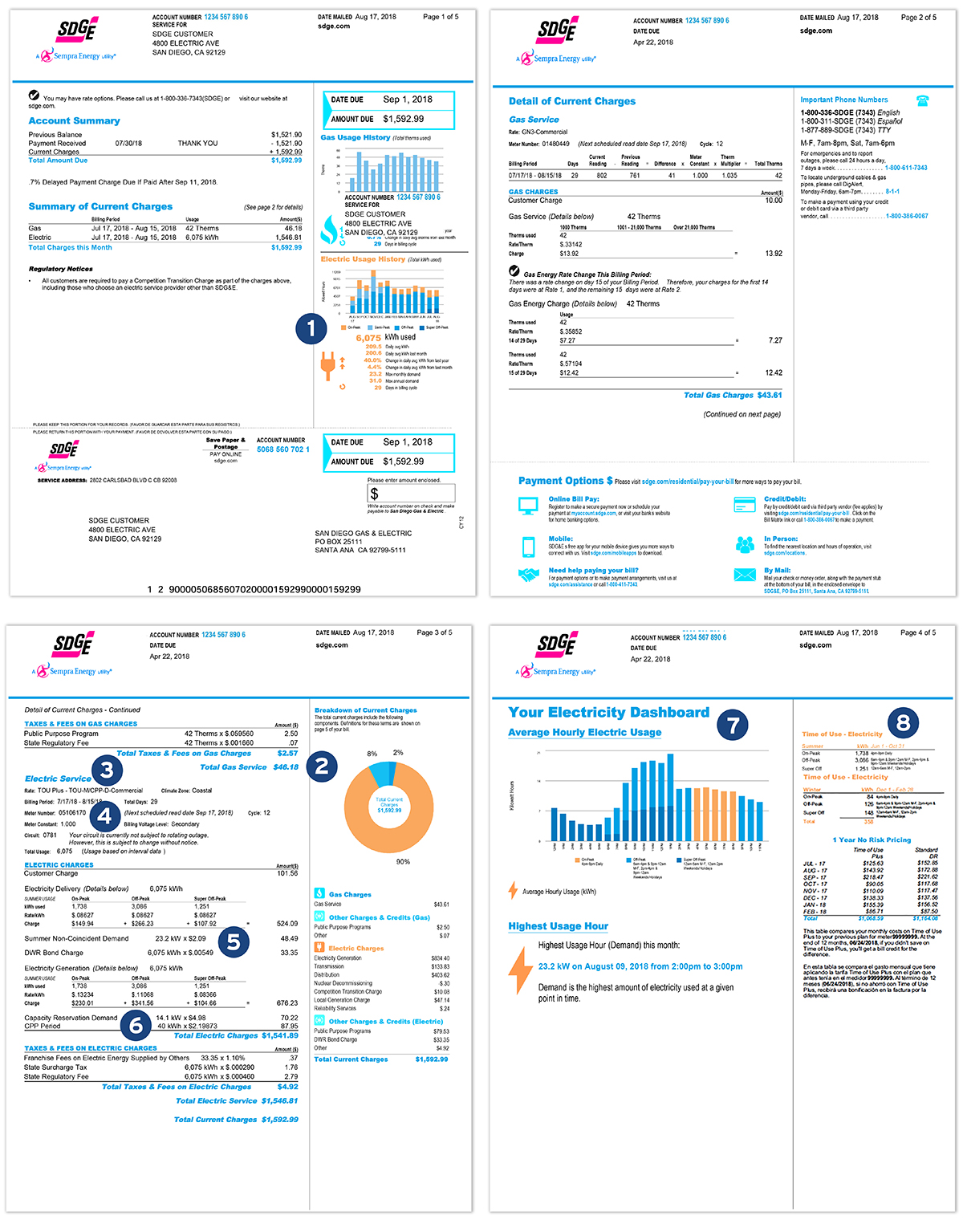
How to read your SDG&E bill
Your SDG&E bill provides a snapshot of your electricity use and costs every month. It’s easier to track and control your energy costs once you know where to look. Here are two sample bills to point you in the right direction.
For a more in-depth look at your energy history, log in to My Account. For details about the charges listed on your bill, look for the “Definitions” and “SDG&E Policies and Notices” sections at the end of each bill, or visit sdge.com/mybill.
Sample Bill | Small Business with Event Day Pricing Plan:
Time of Use Plus (TOU-A-P)

Electric usage history bar graph shows how your current energy use in kilowatt-hours (kWh) compares with previous months dating back to the same month a year ago. Below the graph you’ll find your maximum monthly demand and maximum annual demand. Demand is measured in kilowatts (kW).
Your current pricing plan appears as the electric service rate.
Note your electric meter number and account number, especially if you have more than one meter or multiple accounts. Be sure to select the correct account number when running a pricing plan comparison in My Account.
Breakdown of current charges features a circular chart summarizing the main parts of your energy bill, followed by an itemized list.
Reduce Your Use Day Charge is based on the number of kilowatt-hours (kWh) you actually used during Reduce Your Use event days during this billing cycle.
Your electricity dashboard focuses on your power use for the current billing period, including:
- Average use per hour graphed over a 24-hour period.
- Highest usage hour (demand) for the month.
The Time-of-Use table displays your electricity use by time periods. Energy costs are lowest during off-peak hours, higher during on-peak hours, and highest during Reduce Your Use event days (see “Reduce Your Use Day Charge”).
Sample Bill | Mid-Sized Business with Event Day Pricing Plan:
Time of Use Plus (TOU-M/CPP-D)

Electric usage history bar graph shows how your current energy use in kilowatt-hours (kWh) compares with previous months dating back to the same month a year ago. Below the graph you’ll find your maximum monthly demand and maximum annual demand. Demand is measured in kilowatts (kW).
Breakdown of current charges features a circular chart summarizing the main parts of your energy bill, followed by an itemized list.
Your current pricing plan appears as the electric service rate.
Note your electric meter number and account number, especially if you have more than one meter or multiple accounts. Be sure to select the correct account number when running a pricing plan comparison in My Account.
Non-coincident demand charge is based on the higher of the maximum monthly demand or 50% of the maximum annual demand. It recovers the costs SDG&E incurs to serve individual customers, such as the cost of transformers located at a customer’s site, sized to a customer’s specific load requirements.
Capacity Reservation Demand is a fixed monthly charge based on the number of kilowatts (kW) that you want to protect from the high price of electricity during a Critical Peak Pricing event day. If you don’t specify an amount, then your Capacity Reservation Charge will be based on 50% of your most recent maximum summer on-peak demand. The more energy you reserve, the less the financial impact on an event day, but the more you pay monthly.
CPP Period is the number of kilowatt-hours (kWh) you actually used during Critical Peak Pricing event days during this billing cycle. This is the amount of your CPP use not protected by the Capacity Reservation Charge..
Your electricity dashboard focuses on your power use for the current billing period, including:
- Average use per hour graphed over a 24-hour period.
- Highest usage hour (demand) for the month.
The Time-of-Use table displays your electricity use by time periods. Energy costs are lowest during off-peak hours, higher during on-peak hours, and highest during Reduce Your Use event days (see “Reduce Your Use Day Charge”).